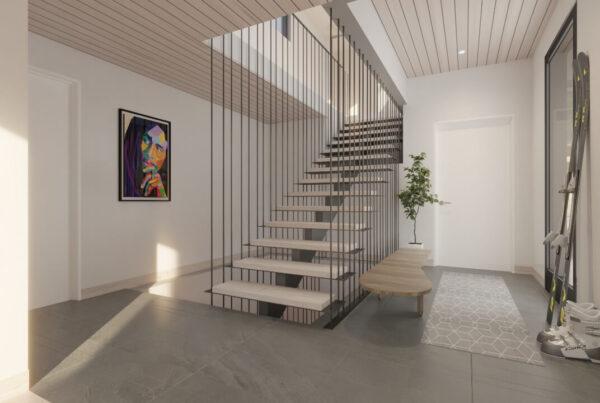BEAM (Building Emissions Accounting for Materials) How Builders Can Use BEAM to Reduce Building Emissions for Climate Action
What is BEAM (Building Emissions Accounting for Materials)?
BEAM, the Building Emissions Accounting for Materials estimator tool, is a user-friendly solution designed to assess the carbon footprint of building materials and provide insights on reducing climate impact. Developed by Builders for Climate Action, BEAM specifically caters to the needs of the low-rise building sector with a focus on energy, sustainability, and moving projects towards zero-emission construction. By inputting your building dimensions, BEAM presents a straightforward and comparative format displaying the carbon footprint of various material options. Users can click on their preferred materials for each assembly and receive comprehensive reports at the material, assembly, and whole-building levels. With its ability to bring clarity to the carbon footprint of building designs, BEAM proves to be a revolutionary tool in the industry.
What does it do and why is that important?
BEAM focuses on the cradle-to-gate analysis of building materials’ carbon emissions, specifically within the low-rise building sector. Unlike comprehensive lifecycle assessment (LCA) tools, BEAM examines the carbon footprint of materials during manufacturing and excludes other lifecycle stages. It calculates carbon storage from biogenic sources, such as recycled newspaper or straw, subtracting it from the emissions generated. The methodology incorporates a safety factor of 5% due to ongoing developments in carbon storage methodologies. The scope of materials includes the structure, enclosure, partitions, and primary finishes, while items like paints, millwork, and appliances are excluded (to be included in future versions). BEAM provides transparent and specific information about the carbon footprint of primary building materials but does not account for every single material. Any outstanding questions or clarifications are addressed before proceeding to an explanation of how to utilize the tool effectively.
Section 1: Using the BEAM Tool for Remodel Projects
When embarking on a remodel project that involves reclaimed salvage materials and rebuilding walls, it’s important to consider the environmental impact. The BEAM tool can help you approach this by accurately capturing the emissions associated with different materials and construction processes. While it may be challenging to assign precise emission values to reclaimed or refashioned materials, the tool allows you to allocate zero emissions to these materials, making them viable options for your project. If there are certain activities that require additional energy consumption, such as using power tools, you can allocate a percentage of emissions accordingly. The tool provides flexibility in accounting for various factors while still providing useful analysis and decision-making support.
Section 2: Estimating the Impact of Excluded Items
In the BEAM tool, there are certain items that may not be included in the calculations, such as small or granular materials. However, these exclusions typically make up a small proportion of the overall emissions. It’s important not to overly focus on the accuracy of these excluded items, as the tool is designed to provide actionable insights rather than absolute precision. For example, items like membranes may not be included, but their contribution to the total emissions is relatively minor. On the other hand, categories like mechanical, electrical, and plumbing systems can have a significant impact, and efforts are being made to incorporate them more accurately into the tool’s database. Overall, the tool allows for practical and effective analysis, even if certain items are not explicitly accounted for.
Section 3: Understanding the Tool and Making Selections
In this section, we learn about how the tool works and how to make selections. The tool automatically populates the quantity entered on the project sheet, which cannot be edited on the current page. If you need to make changes, you can go back to the product page. The net emissions are calculated by subtracting storage from the total or gross emissions. For example, if the installation was 220 kilos and stored 349 kilos of carbon, the net emissions would be the difference between the two.
To make a selection, you can use the checkbox at the top of the page. The tool aims to create a safe space where you can enter data and guides you away from areas where you cannot input information. Green cells can be clicked or edited, while other cells are restricted intentionally. Certain areas may require additional information, such as the R-value for 3D spaces with wall thickness.
The tool also provides a percentage feature that allows you to adjust the size of materials or account for waste. By toggling the percentages, you can modify the quantities without going back to the main assembly page. The select button is used to choose specific materials, and when selected, it is highlighted in orange, and an average subtotal is displayed at the top.
Section 2: Reviewing and Analyzing Results
In this section, we explore the review page and its significance for analyzing results. The review sheet contains all the materials that were selected by checking the checkboxes on previous pages. It serves as a comprehensive list that can be compared and analyzed. By looking at the review page, you can evaluate different elements and their associated emissions. The tool allows for real-time comparisons, eliminating the need to repeatedly run the tool to obtain new results.
If you encounter a situation where the navigation column shows zeros, it is important to ensure that all necessary dimensions and additional parameters are selected. The review page provides a visual representation of emissions using color coding, with the darkest orange representing the highest emissions and the darkest green indicating the most carbon storage. This feature helps identify carbon hotspots in the building design.
The tool also generates a results page that presents project information and material emissions in a formatted manner. This page can be printed as three separate documents or saved as a PDF. It includes an overview of project information, material emissions by section, and total material carbon emissions. Additionally, the results page displays carbon intensity per unit area, allowing for comparison and assessment of building performance.
By saving the project, you can access the project menu, which offers options to designate the project type as either the main project or a baseline. This feature is useful for documenting the reduction of carbon intensity and comparing alternative versions of the building. Multiple alternatives can be created and evaluated to explore different combinations of materials.
Overall, the tool provides a user-friendly interface to understand and analyze the carbon emissions and storage associated with various building materials, enabling informed decision-making during the design process.
Section 5: Analyzing Alternatives and Tracking Design Choices
One of the key advantages of the software tool discussed above is its ability to analyze and compare different design alternatives. By utilizing the alternate sheets feature, architects and designers can easily explore various configurations and materials for their projects. This feature becomes particularly useful during the early stages of design when speed and flexibility are crucial.
With the alternate sheets, users can spin off multiple iterations of their design, each representing a different set of choices. For example, they can compare variations in massing, such as different surface area to volume ratios, to understand their impact on energy consumption. By aligning this analysis with operational energy considerations, designers can gain insights into the relationship between form and energy performance.
It’s important to note that comparing metrics from different tools requires caution and clear communication. While the software tool allows for quick and lightweight analysis, it’s essential to establish a logical framework and coordinate the setup of alternate models. Assumptions and variables should be clearly documented to ensure accurate and consistent reporting of information.
Section 6: Leveraging Data and Optimizing Decision-Making
The completion of a project marks the beginning of a valuable data collection process. Through the software tool, anonymized user data can be utilized to identify patterns, establish benchmarks, and enhance the overall functionality of the tool. Users have the option to contribute their project data, enabling a collective understanding of sustainable design practices and providing insights for future projects.
To retrieve project data, users can access the Project tab and select the desired project and alternates. The tool offers a straightforward process for data extraction, allowing users to choose the relevant project and save it accordingly. Additionally, the tool provides a conversion feature for seamless transitioning between metric and Imperial units, enabling users to work with variables in their preferred measurement system.
The flexibility of the software tool extends to its undo feature, providing a safety net for accidental actions or changes. By simply using the Ctrl+C shortcut, users can undo any unintended modifications and return to the previous state, ensuring a smooth workflow and preventing potential data loss.
In conclusion, the software tool discussed in this blog post offers architects and designers a valuable resource for analyzing carbon emissions and optimizing design decisions. By leveraging its features, such as alternate sheets, data anonymization, and metric conversion, professionals can conduct thorough analysis, compare design alternatives, and contribute to a growing knowledge base of sustainable design practices. With its user-friendly interface and powerful capabilities, the software tool empowers designers to create more environmentally conscious and energy-efficient buildings.






I don’t even know how I stopped up here, but I believed this submit used to be good.
I don’t recognize who you might be but definitely you’re going to
a famous blogger should you are not already. Cheers!
Wow, amazing blog layout! How lengthy have you been blogging for?
you made blogging look easy. The entire glance of your site is great, as neatly as
the content! You can see similar here sklep internetowy
I have been surfing online more than 3 hours as of late, but I never
discovered any attention-grabbing article like yours.
It is beautiful price enough for me. In my opinion, if
all website owners and bloggers made just right content as you did,
the net will be a lot more useful than ever before.